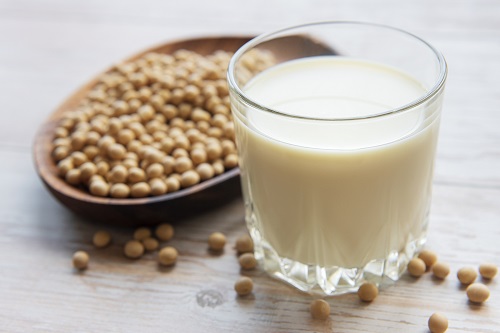June is National Dairy Month, but that doesn’t stop us from enjoying dairy year-round! Whether you sip, scoop, or spread your dairy products—this blog is for you.
Each month this year, we are featuring a different food group or sub-group as part of our Food Talk Features… Series. Last month, we talked about berries and summer fruits. Fruits have special nutrients that may protect against disease! They are also a great way to hydrate because they’re filled with water. Learn more about these delicious fruits here.
This month, we’re moo-ving on to another food group: Dairy! We’ve talked about milk in our Milk in Review blog. Milk is needed to make other dairy foods. Keep reading to learn about why this food group is important!
What are the benefits of dairy products?
Dairy foods are known for their role in building strong bones. But why? It’s because dairy is a source of many nutrients that support bone health! Milk contains 9 essential nutrients. Essential nutrients are nutrients that we need to get from the foods we eat.
The nutrients in dairy foods are great because our bodies can easily take them in and use them! These nutrients include:
- Protein: Keeps bones and muscles strong throughout our lives (in children, adults, and seniors!).
- Calcium, phosphorus, and vitamin D: Build and maintain strong bones and teeth. This includes protection against osteoporosis (the breakdown of bones as we get older).
- Potassium: This nutrient is beneficial for keeping a healthy blood pressure. Most Americans don’t get enough of this one!
- Other nutrients might include vitamin A, vitamin B12, zinc, choline, riboflavin, magnesium, and selenium. Having these nutrients will depend on the product. [1]

Dairy foods include:
- Milk
- Yogurt
- Cheese
- Desserts made with milk (like puddings made with milk, frozen yogurt, and ice cream)
- Fortified soy milk (more on this later!)
Choosing low-fat or fat-free options of milk, yogurt, cheese, and ice cream will help limit the saturated fat. This change in fat content does not affect the nutrients. Low-fat dairy has the same amount of nutrition as whole fat dairy!
Reading the nutrition label is important for choosing options that have less added sugar and saturated fat. Small amounts of added sugars (sugars not naturally present in the food) and saturated fats are okay throughout the day. They should be limited to less than 10% of your daily calories, and they add up quickly! We can choose to limit added sugars and saturated fats in products that don’t need them!
You might also see calcium, potassium, and vitamin D on a nutrition facts label! For most people, the higher the amount, the better. If you’re not sure how to read a nutrition facts label, fear not. Check out this blog on Food Label Facts to make sure you know what to look for on your next shopping trip!

Tummy troubles?
If you get uncomfortable symptoms after eating dairy, you might be lactose intolerant. This means that your body can’t break down a sugar that is found naturally in milk, called lactose. Choose options with less lactose:
- Lactose-free milk (contains the compound that breaks down lactose, so you don’t have to!)
- Greek style yogurt (less lactose because of how it’s made—it’s tart, but tasty!)
- Hard cheeses (the harder the cheese, the less lactose; try Swiss, parmesan, or cheddar)
- Ice cream with a label that says it is lactose- or dairy-free.
You may also be able to tolerate small amounts at a time. Research recommends drinking less than 8 ounces of milk at once. Drinking milk or eating other dairy foods with a meal will also help reduce stomach aches! [2]
There is a myth that milk and dairy products cause inflammation in the body. Current research shows that milk is not inflammatory. In fact, researchers see an anti-inflammatory effect, which is good news for us! [3] [4] Continue to focus on finding dairy foods that you will enjoy so you can support your muscles, bones, and teeth.

Are there other options if I choose not to consume dairy foods?
If you are allergic to dairy or choose not to consume it, you still have options! Nutrition professionals like dairy because of the easily absorbed protein, calcium, and vitamin D. Most Americans get a majority of their calcium from dairy products! [1]
Without dairy, we need to be sure to find these nutrients in other foods and drinks. When looking for a substitution for dairy, check the nutrition facts label… And watch out for added sugars!
According to the 2020-2025 Dietary Guidelines for Americans, fortified soy milk is the best replacement for milk. This is because “fortified” means they added important nutrients like calcium, vitamin A, and vitamin D to the carton. Soy milk is also naturally higher in protein. This drink checks all the boxes!
For tips on keeping up with calcium, vitamins, and protein without eating dairy foods, check out the end of our Milk in Review blog.

How much do I need?
Most children, teens, and adults should aim for about 3 cups of dairy foods per day. Young children should get 2 to 2 ½ cups. Children under the age of 1 should follow recommendations from their pediatricians.
A 1-cup-serving of dairy depends on the food or drink. One serving is about:
- 1 cup of liquid milk, pudding made with milk, yogurt, and frozen yogurt
- Two slices of hard cheeses (or 1/3 cup shredded cheese), ½ cup of ricotta cheese, and 2 cups of cottage cheese
- 1 ½ cups ice cream
Differences in servings are based on the amount of dairy in each food. For example, ice cream has more fat, sugar, and water. This means that amounts of dairy nutrients are lower with a smaller serving size.
Some of these foods, like cheeses and ice cream, contain more saturated fat that we want to limit. For this reason, vary your dairy sources every day. You’ll get a good mix of nutrients without going over on saturated fat! [1]

Dive into These Dairy Dishes
If you don’t like drinking milk but want the benefits of dairy, try mixing milk into other foods (like pudding, oatmeal, and smoothies). For similar nutrients, opt for other dairy products like yogurt and cheese! [5]
Check out these delicious dairy dishes from Food Talk:
- Enjoy shredded cheese with our Breakfast Tacos or Fiesta Quesadillas.
- Sip on a yummy Strawberry Smoothie or Pumpkin Spice Latte made with milk. Or try our 4-Fruit Smoothie with yogurt.
- Scoop up some yogurt in our Banana Pudding Overnight Oats, Creamy Pineapple Pudding, Amazing Banana Pudding, or Yogurt Crunch Parfait.
- Find creamy dairy in every bite of our Skillet Mac and Cheese and Crockpot Vegetarian Lasagna
- Munch on refreshing Fro-Yo Drops with your kids, or whip up Berry Popsicles and Strawberry Frozen Yogurt for the whole family!
Dairy products offer so many nutrients in a small package! What’s your favorite way to eat dairy?
Written by Melanie Ng, Ph.D. Candidate | Reviewed by Leslie Davis, MS, RD, LD, CDCES and the Nutrition Education Team
Posted: June 14, 2021

